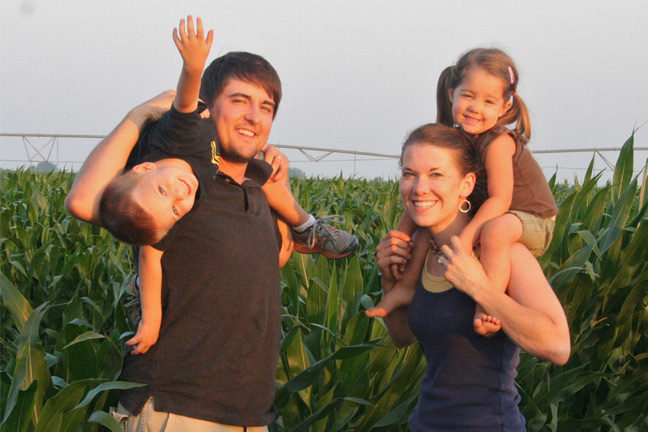
Agricultural News
World Food Day Highlights Crucial Role of Family Farmers
Tue, 15 Oct 2013 11:29:13 CDT

On October 16th, World Food Day will call attention to the crucial role that family farmers play in creating a more sustainable global food system - and it couldn't come at a more opportune time. As the global population approaches nine billion by the year 2050, nourishing the world and preserving diminishing environmental resources presents a daunting challenge.
Today, nearly one billion people go to bed hungry each night. By 2030, it's estimated that 47 percent of the world will live in areas of high water stress. The U.N. Food and Agriculture Organization (FAO) estimates that 25 percent of all global land has already been highly degraded and can no longer be used to grow food.
The focus of World Food Day 2013 will be on "Sustainable Food Systems for Food Security and Nutrition." More and more evidence is mounting to show that family farmers are at the center of sustainable food production. Smallholder farmers can use agroecological or environmentally friendly farming practices to produce more nutritious foods with often greater yields than conventional farming operations. And with 2014 having been declared the International Year of Family Farming by the U.N. General Assembly, the whole world is poised to celebrate the multitude of ways in which family farmers contribute to food and nutrition security and environmental preservation.
Smallholder farms are more likely to grow diverse, nutrient-rich crops than conventional farms, which tend to focus on starchy cash crops - including corn, soy, and wheat - that are good at filling people up, but don't have much nutritional value.
"Small-scale farmers hold the key to cultivating and preserving biodiversity in agriculture. They grow indigenous fruits, vegetables, and legumes all over the world that not only make up diverse, healthy diets, but also provide much-needed nourishment for soils, conserve limited water resources, and cut down on the release of greenhouse gases into the atmosphere," says Danielle Nierenberg, Food Tank's co-founder.
Studies have shown that when family farms start using sustainable methods, they see crop yields that are up to 79 percent higher than those produced by conventional agriculture. This translates to more food for the world, and greater financial security for farmers. An estimated 800 million people working in agriculture around the world live below the poverty line, and approximately half of the world's hungry are smallholder farmers.
"Providing these farmers with the resources that they need to provide food for themselves and their communities will go a long way toward alleviating food insecurity and increasing incomes where most needed," says Ellen Gustafson, co-founder of Food Tank.
These are six crucial ways in which small-scale family farmers cultivating diversified crops are contributing to a food system that both nourishes more people and conserves environmental resources.
1. Improving nutrition and food security - Many case studies from Madagascar, Iran, India, and Bangladesh have confirmed that diverse diets are correlated with better nutrition, particularly in children. In a landmark study that covered ten countries on three continents, the International Food Policy Research Institute (IFPRI) found that diverse diets are positively associated with access to food and increased food security.
2. Preserving biodiversity - In the 20th century alone, 75 percent of the planet's genetic resources were lost. FAO warns that losing crop biodiversity poses a serious threat to global food security. By cultivating a wide variety of indigenous crops, small-scale farmers are preserving biodiversity in agriculture.
3. Increasing yields - Polyculture operations-farms growing many different varieties of crops-produce yields between 20 and 60 percent greater than monocultures.
4. Building soil health - Land and soil degradation can cause a loss of nearly 50 percent in crop productivity. But practices such as cover cropping and intercropping can help to rebuild lost nutrients in degraded soil by creating shade and stimulating the growth of beneficial microorganisms.
5. Conserving water - Healthy soils are able to absorb water and deliver it to plant roots more effectively than degraded soils, and require less irrigation. By enriching soils through the cultivation of legumes such as the pigeon pea, cowpea, and clover, which help to preserve soil moisture through insulation from sun and wind, farmers can cut down on their use of valuable and limited water resources. Cover crops have also been shown to reduce nitrate runoff into groundwater reserves.
6. Mitigating the effects of climate change - According to the International Fund for Agricultural Development (IFAD), diversified and indigenous crops are typically more resilient to extreme weather conditions, including drought, flooding, and high temperatures as a result of climate change. And FAO has found that traditional farmers have implemented indigenous and heterogeneous crop varieties as tools to recover from natural disasters. Cultivating a wide variety of species of plants also can help insulate farmers against the risk of plant disease.
To ensure that everyone on the planet has access to sustainable sources of nutritious food, it's important that efforts to support small-scale farmers be scaled up on a global level.
Throughout the week of World Food Day, Food Tank will highlight important ways that small-scale farming is helping to build healthier communities and a healthier planet.
WebReadyTM Powered by WireReady® NSI
Top Agricultural News
More Headlines...




















